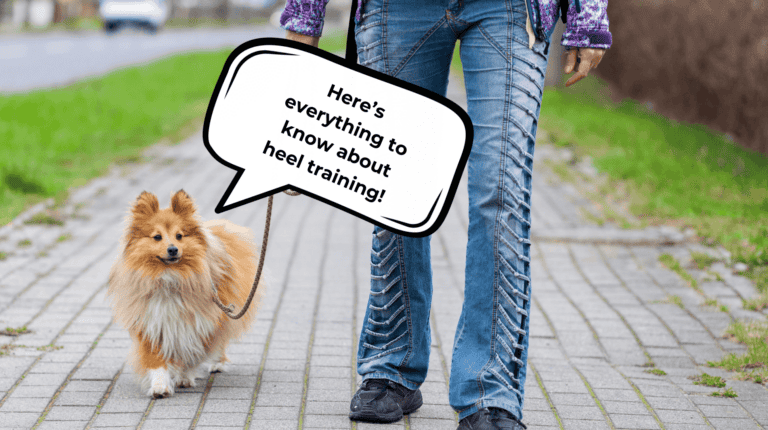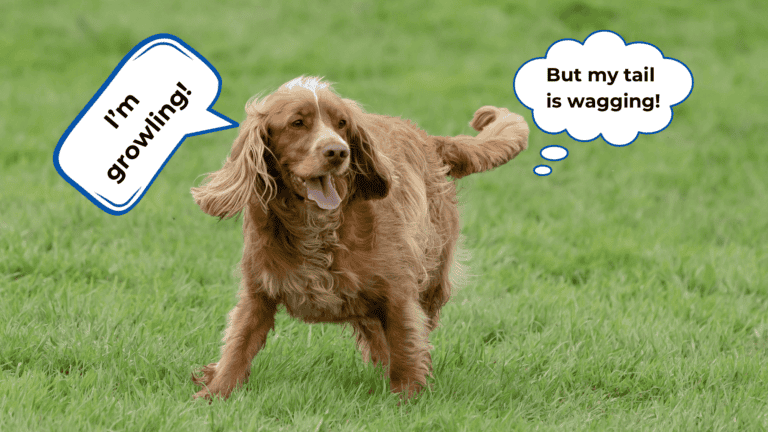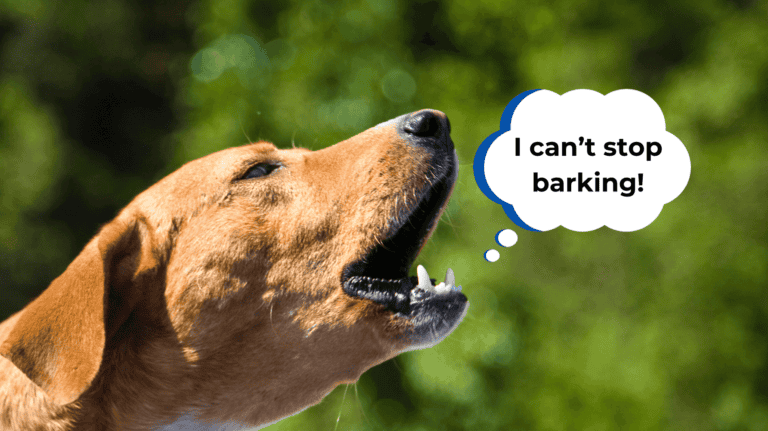Using dog psychology requires a deep understanding that our dogs do not think like us.
We love our dogs, and we want to communicate with them and know what they are thinking. But here’s an important truth: dogs do NOT think like humans!

One of the most common dog training and dog care mistakes is that we communicate and relate to our dogs using human psychology. Typically, we view them as young children. This is where everything goes wrong because using human psychology on our dogs can only lead to misunderstandings.
By understanding dog psychology, you can help identify the reasons for certain dog behavior such as non-stop barking, running away episodes, and unexplained aggression.
With dog psychology, you’ll find solutions to their behavioral issues better because you finally get your dog.
So how can you master dog psychology in communicating with and raising your dog?
Read on to learn more!
Key Takeaways:
- Dogs don’t think like humans. And if you use human psychology to understand a dog, it can lead to misunderstandings.
- Your dog has an innate and natural behavior. These natural instincts are there to help dogs be safe and thrive.
- When you understand dog psychology and your dog’s natural instincts in dog training, you can teach your dogs in a better way.
JOIN MY FREE REACTIVITY CLASS
Table of Contents
- Using Dog Psychology to Understand Odd Dog Behavior: The Story of Zippy
- Dog Psychology: How to Know How Dogs Really Think
- Top 6 Unique Dog Behaviors Explained Through Dog Psychology
- Dog Psychology: Five Ways You Can Understand and Interpret Your Dog Better
- Using Dog Psychology and Dog’s Natural Behavior to Improve Dog Training
- Conclusion: Dog Psychology is One of Your Biggest Tools in Dog Training!
Using Dog Psychology to Understand Odd Dog Behavior: The Story of Zippy
My experience with Zippy is what stands out the most whenever I have to emphasize to dog owners how dog psychology benefits both them and their pets.
(Watch the video below for Zippy’s story)
Zippy’s a lovely dog! You could say that she’s an “almost-perfect” dog.
She’s very obedient, she comes when called, she’s relaxed, and she’s the best at potty training.
But one day, Zippy began showing odd behavior: SHE WAS CONSTANTLY RUNNING AWAY FROM HOME!

Despite putting up a fence, covering holes where Zippy typically goes through — Zippy would still find a way to run off.
The story became more interesting when the owners said she would go to another house where a male dog lives.
It only made sense when Zippy’s lady-owner said “The same thing happened when I was pregnant last time.”
I asked “Are you also pregnant now?”
The lady said yes.
I immediately knew why Zippy was running away.
LEARN THE DOG CALMING CODE (FOR FREE)
Zippy has always felt that she was the alpha of her “pack” and for her, bearing puppies should be HER role.
To her, it was a travesty of justice that some other woman in the pack would be birthing a pup.
So in true alpha female fashion, Zippy runs away to another home to build her own pack with another dog.
At first, it was a surprising realization for owners. But I explained to them: you have to use dog psychology to really know how dogs think!
Dog Psychology: How to Know How Your Dog Thinks
Dog owner, it’s important to understand the nature of your dog before you start training them. This effort includes knowing the psychology of dogs, honoring their natural state, and respecting how THEY see the world. You should acknowledge how your dog sees the world BEFORE you impose your human interpretation.

Only by doing so can you make a real relationship with your dog built on trust and understanding.
Here is some basic info to remember when it comes to learning how dogs think.
GET MY 5 GOLDEN RULES FOR FREE!
#1: Dogs Act on Instinct and What’s Natural to Them
Dog behavior such as barking, or aggression, or even restlessness can be attributed to a dog’s instinctual reactions, NOT just because they’re acting up. Same with other animals, dogs have natural instincts that are there to help them survive.
A dog’s instinctive behavior is passed down through genetics and is usually a result of what their breed is genetically-engineered to do. Even as domesticated breeds, dogs will naturally engage in various activities such as hunting, digging holes, shepherding, and barking, all of which serve a purpose and remain part of their inherent behavior.

Let’s take a look at some examples.
Dogs pee everywhere because that’s what they feel is natural; when they feel the need to pee, they will pee.
Our dogs are also very protective. When a dog feels that they are the “pack leader,” their instinct to protect heightens. Barking — one of the dog behaviors that can really get on the nerves of dog owners — is one of the signs that a dog is fierce in protecting the household.
In Zippy’s story, she wasn’t running away just because she wants to give her owners a hard time — she was doing what was natural for an alpha female.
REVERSE REACTIVITY (FREE WEB CLASS)
Can you imagine how frustrating it would be for you and your dog if you interpreted everything through the lens of human psychology?
#2: Some Dog Breeds Are Predisposed To Do Things Differently Than Others
Dog instinct is part of a dog’s innate behavior — it’s built into them. Some breeds — despite being domesticated — have it in them to exhibit unique behavior.

For example, beagles tend to run around a lot because they were previously used for hunting rabbits. Greyhounds are hunters, so they can still show signs of this through their high-speed running. Border Collies love shepherding because that’s what they are predisposed to do.
#3: Dogs Don’t Speak Our Language But There Are Ways That Can Help Them Understand Us
“Doggy Dan, I’ve been telling my dog over and over again to do this. But they just don’t get it!”
Here’s an important fact: dogs don’t speak English. They don’t speak the language of humans. HOWEVER, dogs can interpret what you are trying to say through assessing your body language, the tone in your voice, and association with rewards and punishments.
REACTIVITY SOLVED (NO FOOD, NO FORCE)
In my program the Dog Calming Code™️, dog owners will find ways how to command behavior or communicate something to their pets using a strategy that dogs will understand.
Why am I keen on making sure dogs and dog owners get each other? Because when you take misunderstandings out of a pet-owner relationship, both the training and relationship improves.
Top 6 Unique Dog Behaviors Explained Through Dog Psychology
Through learning dog psychology, dog owners can feel less frustrated, and smarter in addressing dog behavior issues.
To our human eyes, some of these behaviors can appear as odd, weird, or not making sense.
However, the natural instincts that cause odd dog behavior serve a purpose: to protect, feed, and keep them alive.

Like what I mentioned above, dogs act on what’s natural and instinctual to them. Let’s take a look at six unique dog behaviors through the eyes of our dogs.
Behavior #1: Why Do Dogs Dig Holes?
Ah, digging!
It's an age-old habit that's deeply ingrained in dogs.
Why do dogs dig holes?
In the wild, dogs used to dig to create safe and comfortable dens for themselves or to hide food from potential scavengers. Even though they might have cushy beds now, the urge to dig is just too hard to resist sometimes.
JOIN MY FREE REACTIVITY CLASS
Behavior #2: Why Do Dogs Bark?
Barking is their way of communicating with the world.
Dogs may bark to alert humans of potential threats, to express excitement or anxiety, or simply because they heard something intriguing.
Sometimes, your dog just wants to get your attention and make sure you know they’re there and ready for some fun!
Behavior #3: Why Are Dogs So Protective of Food?
Food is precious to dogs, just like it is to most living beings. Dogs need food to survive, so food is like GOLD to them! All a dog needs to feel rich is to have a full tummy. It is EVERYTHING to them.

In the wild, resources can be scarce, so dogs learned to guard their food to ensure their survival. Even though their bowls are filled regularly now, that instinct to protect what's theirs still remains.
In one of the Golden Rules of my online program, the Dog Calming Code, I teach that dogs who hide their food also feel that they’re in control of the food. It’s one of their ways to assert leadership.
LEARN THE DOG CALMING CODE (FOR FREE)
Behavior #4: Why Do Dogs Bury Toys and Food?
It might seem odd to you, but it stems from a dog’s ancestry. In the wild, dogs used to bury excess food to keep it safe for later. It's like a built-in pantry for the future. Even though they no longer need to store food this way, old habits die hard!
They will bury their bones, rawhide and pigs ears, then dig it up whenever they want — often to express their leadership in front of others in the family.
Similar to hiding food, dogs who control the toys are also displaying their household leadership. By displaying YOUR slipper or the dog's favorite toy in front of you, in THEIR possession, it shows you they have a firm grasp of who's in charge…and it's NOT you!
Behavior #5: Carrying Things
You might have noticed how dogs love carrying random objects around, like your shoes, socks, or toys. It's a throwback to their ancestors, who would carry prey or other items in their mouths. To dogs, it's like a game and a way to bond with you — after all, sharing experiences is what companionship is all about.

Behavior #6: Licking
Licking is one of the versatile behaviors in dogs. It's how they groom themselves and show affection to both humans and other dogs. In the wild, licking also played a role in social bonding among pack members. So, next time your dog gives you a good lick, know that it's their way of saying “you're part of our pack!”
As you observe these behaviors, remember that they are rooted in evolutionary history.
While dogs have become beloved companions in your homes, the instincts of their wild ancestors still run through their veins. Embracing these unique behaviors with understanding and patience will make their bond with you even stronger.
GET MY 5 GOLDEN RULES FOR FREE!
Dog Psychology: Eight Ways You Can Understand and Interpret Your Dog Better
Familiarizing with dog psychology and how dogs think requires conscious effort on our part. It’s going to be hard, but it will significantly change how you see your dog and how you train them.
Here are some ways you can get your dog better.
Tip #1: Observe Their Body Language
Dogs communicate mostly through body language. Pay close attention to their tail, ears, eyes, and overall posture to gauge their emotions and intentions. By understanding their non-verbal cues, you can respond appropriately and strengthen your connection.
Tip #2: Search About Their Breed to Understand Dog Psychology Better
Dogs are not created equal, and some breeds are unique than the rest!

Researching your dog's breed traits and history provides valuable insights into their natural instincts and behaviors. Each breed has unique characteristics, and understanding them will help you tailor your training approach to suit their needs.
Tip #3: Lead with Gentleness
Dogs can’t operate well when there’s fear.
When dogs can’t show their true nature to you, it will be more difficult to know how to train them better.
Training should be a positive experience for both you and your dog. Approach it with gentleness, patience, and kindness. Avoid using harsh methods, as they can cause fear and hinder the learning process. Positive reinforcement encourages better results.
FREE REACTIVITY MASTERCLASS
Tip #4: Be the Pack Leader
Dogs are instinctively pack animals and look for a confident leader.
Establish yourself as the pack leader by setting clear boundaries and rules. A consistent and confident approach helps your dog feel secure and more willing to follow your guidance.

When they see you as a pack leader, they can connect with you better because they trust you. And when your relationship is that of trust and understanding, you’ll start to see why your dog behaves the way they do.
My program, the Dog Calming Code, can help you make this happen!
Tip #5: Be Consistent
Be consistent with your commands and routine. It is in consistency that certain behaviors that tell something about your dog stand out.
Tip #6: Use Timeouts and Positive Reinforcements
When your dog displays unwanted behavior, consider using timeouts to redirect their attention. At the same time, reinforce good behavior with positive rewards like treats, praise, or affection. This encourages your dog to repeat positive actions and learn from their mistakes.
Tip #7: Take Time and Be Patient
Remember that being a master of dog psychology is a gradual process that requires time and patience. Every dog learns at their own pace. Celebrate small successes and stay patient throughout the training journey. Being patient and understanding helps build trust and confidence in your dog.
Tip #8: Get Dog Training Help
An amazing shortcut to understanding dogs better is getting guidance from professional dog trainers!
REVERSE REACTIVITY (FREE WEB CLASS)

In my online dog training program, the Dog Calming Code, I offer strategies that help dog owners connect to their pets better through communication strategies that dogs easily get!
Using Dog Psychology and Dog’s Natural Behavior to Improve Dog Training
One of the biggest frustrations in dog training comes from wanting to change our dog completely. But here’s a beautiful fact: you can actually use your dog’s natural behaviors to your training advantage.

In dog training, tapping into dog psychology, embracing their innate behaviors, and getting in tuned with how dogs think can unlock the key to effective and harmonious training methods. Instead of attempting to reshape a dog entirely, aligning training techniques with their natural instincts proves immensely beneficial.
Here are some ways how understanding dog psychology and their natural instincts can help in dog training.
#1: Through Dog Psychology, You Build Understanding and Trust Which Are Important to Dog Training
By understanding and respecting their unique behaviors, we create a bridge of communication that fosters a deeper connection.
This approach empowers both the dog and the owner, paving the way for successful training experiences based on trust and mutual understanding.
REACTIVITY SOLVED (NO FOOD, NO FORCE)
#2: With the Help of Dog Psychology, You Will Know How to Teach Your Dog Best
With dog psychology, you'll learn how to teach your dog in a fascinating way. By understanding their instincts and behavior, you'll tailor your training methods effectively.

This helps you communicate with them better, creating a strong bond based on trust. Armed with this knowledge, you'll find the best approaches to guide your furry companion's learning and growth, forming a lifelong connection.
#3: You’ll Find the Best Ways For Mental and Physical Stimulation
If your dog is not that enthusiastic with the games and exercises you have prepared for, don’t fret.
Your dog might not be a runner or a walker, and they might prefer another activity for physical and mental stimulation.

By knowing dog psychology and how dog’s instinct works, you can come up with better activities that both you and your dog can enjoy.
#4: You’ll Train With Love and Understanding
By comprehending their emotions and innate communication signals, you can adapt your training methods to resonate with their unique perspective. Replacing harsh discipline with positive reinforcement and patience fosters a bond built on love and trust.
This mutual understanding creates a safe environment where your dog feels secure, motivated, and eager to learn. With each training session, your connection deepens, resulting in a well-behaved and emotionally fulfilled companion that brings immeasurable joy to your life.
JOIN MY FREE REACTIVITY CLASS
Conclusion: Dog Psychology is One of Your Biggest Tools in Dog Training!
When you really know how your dog thinks, you save yourself from the frustration of feeling like no training ever works!

Yes — you even save yourself from using training strategies that are not compatible with your beloved pet.
When you apply dog psychology to dog training, it just clicks on you what’s best for your dog. You begin communicating in a way that your dog understands. Your relationship begins to shift from exhaustion, to one that actually brings joy.
I can’t stress this enough: understanding dog psychology is one of the biggest factors that make dog training successful.
A true, clear, and deep understand your dog is as important as any training technicalities.
When you get them, your dog will absolutely thank you.

~ Doggy Dan








2 Responses
“What an insightful article on understanding how dogs think! It’s so important to learn about dog psychology in order to better communicate and bond with our furry friends. Thank you for sharing this valuable information! – Ashley Fowler”
You’re very welcome